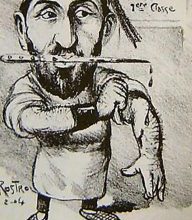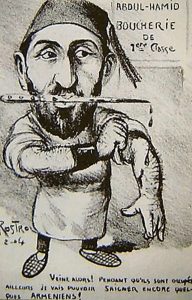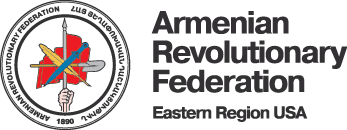The Power of the Press: 1895 News from Armenia


‘[The article] referred to Sultan Hamid, infamously called the Bloody Sultan, responsible for the death of thousands of Armenians from 1894-95.’
Never underestimate the power of the press. A newspaper is a powerful instrument used to inform, educate, and entertain readers. Because of the Armenian Weekly I am here to “talk to you.”
Unfortunately, in recent years we have witnessed the demise of many newspapers, replaced instead by television network and cable broadcasts, and hand-held technological instruments.
In November and December 1895, the Petoskey Record of Northern Michigan featured an article that was of great interest to its small immigrant Armenian population. It also informed the general readers of the harsh reality of life in Turkey and in Historic Armenia, a far-off land that so few were acquainted with.
It’s interesting to note that the small Armenian population of Northern Michigan must have been regarded in high esteem to receive such coverage, especially in November and December when the area’s summer tourist trade had returned to their residences in other parts of the country.
The newspaper article was headlined, “The Sultan’s Tyranny Is Felt Even in the State of Michigan.” It referred to Sultan Hamid, infamously called the Bloody Sultan, responsible for the death of thousands of Armenians from 1894-95.
It is thoroughly thought provoking to consider the reality of how day-to-day living must have been under the sultan’s rule. Reality is that life for Armenians in their indigenous homeland was always tenuous under Turkic rule.
Imagine this, the years of rampage (1894-95) were only 30 years after the end of the Civil War of the United States. Did any of the news reports of this historic event reach the Ottoman Empire or Sultan Hamid? Was our part of the civilized world here in the United States so far away that it had no frame of interest or importance to the Turks?
Why would a small resort town—Petoskey, located on Lake Michigan—with a booming summer tourist trade concern itself with news reports from a far-away empire?
Life for Armenians in the Ottoman Empire normally was a litany of gloom as second-class citizens, referred to as gavoors, Christian non-believers, and was being reported as such by the Petoskey Record.
Mr. Asadoorian, a successful Petoskey businessman, had received a letter from a friend that caused him much distress. His mother lived in Ichmah, 35 miles east of Harpoot. From there his friend writes, “Ichmah contained about 800 Armenians and the rest were Turks. Three weeks ago the Armenians were called together and notified that unless they recanted Christianity and became Muslims all their leading men would be killed. Led by their old pastor, a man of about 75 years, they refused to do so and the butchery began, starting with their elderly clergyman.”
It was not known whether Asadoorian’s mother was included among those killed.
The newspaper’s reaction to the carnage was this: “People here who sit on soft cushions Sundays don’t know what it costs to be a Christian in some parts of the world.”
The news of the massacre of Christians at Harpoot was of interest because one of Petoskey’s leading businessmen—Mr. Asadoorian—came from there. Asadoorian had been working through the United States consuls and Armenian friends to bring his wife and child to America, but received little encouragement.
Recently he had made arrangements for them to be sent to the coast on Nov. 1, but whether they escaped from Harpoot before the massacre began or were frightened by the disturbed conditions of the country and feared to start, he does not know.
The dispatches said that 8 of the 12 buildings belonging to the Armenian Mission at Harpoot had been burned. That too was of local interest here in Petoskey because Asadoorian, a carpenter by trade, had helped build them. He assisted in putting on the first shingle roof ever seen in Armenia.
The newspaper says, “It is to be hoped that Mrs. Asadoorian escaped to the coast before the massacre occurred. Good heavens! How we would like to see such an army of Yanks and Johnnies as Sherman and Johnson (1864 Civil War) turned loose in Armenia to deal with the women and baby killing brutes.”
My belated gratitude to that wonderful newspaper who boldly put into print, “If mutual jealousies prevent immediate action by the Allied Powers we sincerely hope San Francisco will open up the ball by pitching shell into the Old Seraglio and the Sublime Port.”
As we know all too well, conditions only worsened in Ottoman Turkey.
How proud and thankful we Armenians are to Pope Francis for his June 2016 visit to Armenia and his planned visit to the Tsitsernakaberd Armenian Genocide Memorial Complex, to Gyumri, and to Yerevan’s Republic Square, where he held an Ecumenical Encounter Prayer for Peace.
If ever there was a time for all Christians to unite it is now, as we are being wantonly killed in so many places throughout our world. Pray for unity, pray for peace.
Source: Armenian Weekly Mid-West
